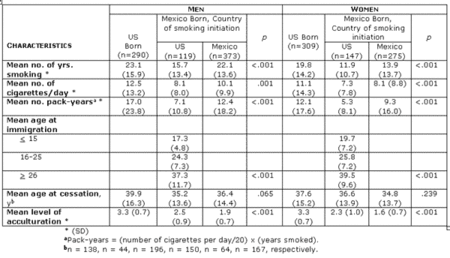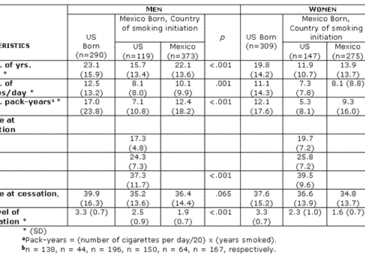After migrating to a new country and living there for an extended period of time, people inevitably adopt some new cultural, lifestyle, and health patterns. This holds true even if some of those patterns are not particularly healthy, such as smoking. There is a growing Mexican-American population in the US; currently little is known about their smoking patterns based on country of birth. This ASHES review summarizes a study by Wilkinson and colleagues (2005) that examines differences between U.S.- and Mexican-born smokers, to determine the extent to which exposure to US culture impacts smoking behavior among immigrants.
The researchers drew participants for this study from an ongoing population-based household study by the Department of Epidemiology at the M.D. Anderson Cancer Center in Houston, TX. Between July 2001 and April 2004, this ongoing study recruited residents of predominantly Mexican American neighborhoods in the Houston area through random-digit dialing, and canvassing door-to-door, community centers, and local health clinics. In addition, this study networked through already enrolled participants. Bilingual interviewers recruited up to 3 additional family members over the age of 5 in each household; interviewers collected demographic characteristics, medical histories, level of acculturation (1), social habits, occupational and residential histories, as well as smoking status (i.e., current smoker, former smoker, never smoked).
A total of 5,030 participants were included in the Wilkinson et al. study (1,392 men and 3,638 women); 70% of these participants were born in Mexico. Data from 5,512 participants were available for analysis; of these participants, 14 were excluded due to lack of information, 468 were excluded because they lived in a census tract area with censored information (i.e. the census tract included fewer than 20 people) or information was missing for their census tract.
Of the Mexican-born participants in this study, 75.8% of men and 65.2% of women had started smoking before migrating to the US. Among Mexican-born participants who initiated smoking after migrating to the US, this study found that they smoked fewer cigarettes per day and smoked for fewer years (thus smoking for a lower average number of pack-years (2)), than participants who were US-born. There was little difference in the age of initiation among Mexican-born participants who migrated before age 15, US-born participants, and Mexican-born participants who initiated smoking in Mexico. Generally, Mexican-born participants who were ‘ever smokers’ and had initiated smoking in the US, had resided in the US for a longer period of time at time of data collection than Mexican-born ‘never smokers.’
This study found four significant predictors of ‘ever smoking’ among Mexican-born participants after migration to the US: 1) older age; 2) male; 3) higher level of acculturation; and 4) younger age at immigration.

Figure. Smoking initiation and nativity status (adapted from Wilkinson et al., 2005). Click image to enlarge.
In this study the rate of smoking among US-born Mexican-American males was similar to that of African American males (approximately 30%). Among women, those who are Mexican-born are half as likely to smoke as women who are US-born. ‘Never smokers’ were more likely to be Mexican-born. Among Mexican-born participants who began to smoke after migrating to the US between the ages of 16 and 25 years, the average age of initiation was 24.3 years among men and 25.8 years among women, and a large number of Mexican-born participants who migrated after age 26 initiated smoking after migrating. This evidence suggests, not surprisingly, that (1) the US cultural norms influenced behavior among Mexican-born immigrants, and (2) the younger age at immigration and higher level of acculturation increases likelihood of smoking.
There are several limitations to the study. The researchers were unable to assess the impact of smoking among family members, because they did not collect smoking information from everyone in each household. All reports of smoking were self-report. Therefore, participants might have under reported their rate of smoking, especially if it is culturally less acceptable for Mexican women to smoke. Remember, the results showed that this was the group of participants who smoked the least. Nonetheless, this study describes interesting differences between US- and Mexican-born populations in the direction of more cigarette smoking among US-born Mexican-Americans. Future smoking prevention and cessation programs should be adjusted to better address the unique risk factors associated with this immigrant population and provide resources that are more culturally sensitive. Perhaps prevention and treatment programs would be more effective when properly matched to the target population.
— Siri Odegaard.
Notes
1. Based on a scale from 1-4; higher scores reflected more English language fluency and higher level of acculturation.
2. Pack-years = (number of cigarettes per day/20) x (years smoked)
References
Wilkinson, A. V., Zpitz, M. R., Strom, S. S., Prokhorov, A. V., Barcenas, C. H., Cao, Y., et al. (2005). Effects of Nativity, Age at Migration, and Acculturation on Smoking Among Adult Houston Residents of Mexican Descent. American Journal of Public Health, 95(6), 1043-1049.
What do you think? Please use the comment link below to provide feedback on this article.




